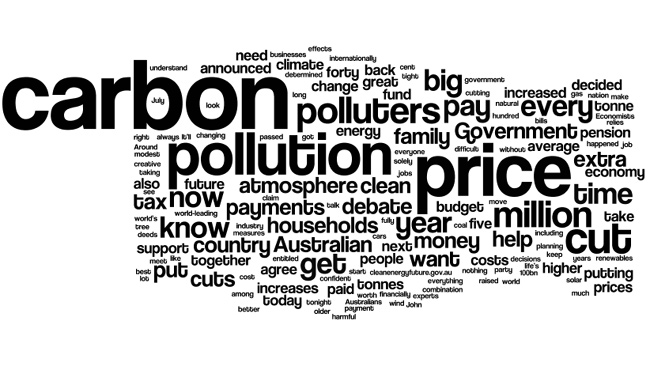Carbon Tax: A Corpus Christi Economics Essay – Joe Buckley
In 2006, the economist Nicholas Stern wrote:
‘The science tells us that greenhouse gas emissions are an externality; in other words, our emissions affect the lives of others. When people do not pay for the consequences of their actions we have market failure. This is the greatest market failure the world has seen.’
An externality is the cost or benefit that affects a party who did not choose to incur that cost or benefit which is why governments want these policies to be internalised. This internalisation makes firms face the true cost and not just the private cost of their carbon production by increasing the costs of production. Carbon emissions are to a large extent a negative externality that affects the entire world. This is because if carbon emissions continue there may be a dramatic increase in sea-level rise, droughts and the extinction of hundreds of rare species. According to National Geographic ‘We can expect the oceans to rise between 2.5 and 6.5 feet (0.8 and 2 meters) by 2100, enough to flood major cities on the East Coast of the United States’. However, there are conflicting figures which provide evidence that the global warming caused by carbon emissions is not as serious as some people say. For example, the European Space Agency found out that since 2012, Arctic ice has increased in volume by 50% even though activists such as Al Gore predicted that all arctic ice would be gone by 2013. Furthermore, there is also an argument that the externality is actually beneficial to the environment. This is because when carbon emissions increase, so does the concentration of vegetation. An article written by the National Review explains how there has been a 19% increase in carbon dioxide, with plant growth in the United States increasing by 14%. Therefore, when considering the implementation of a carbon tax, it is necessary to evaluate both sides of the argument.
One of the key ways carbon emissions are created is by heavy industries burning fossil fuels on a large scale. However, the huge environmental cost the world experiences is mainly due to businesses failing to balance the social cost and social benefit of their output. This is because they fail to realise the true cost of their production because they do not directly pay for the environmental externality. This causes deadweight welfare loss to society as the level of carbon production is not at its socially optimum point.
Carbon emissions cause environmental hazards such as air pollution which can cause health problems such as bronchitis, especially in developing countries that are industrialising at a fast rate. A good example of this is China which has one of the most polluted atmospheres in the world, which leads to the deaths of around 4,400 people every day. This is because China has very few regulations on heavy industries compared to a country such as the U.K. However, it is also due to the fact that China wants to continue its consistently high economic growth, with economic growth averaging at 10% annually for 30 years until 2015. Therefore, China wants to continue its more free market approach which encourages growth by infrequently intervening with business affairs. However, recently China has been taking steps to tackle its problem with carbon emissions by agreeing to take part in the Paris climate deal and considering the implementation of a carbon tax. This has led to China cutting emissions, for example in 2012 carbon dioxide emissions only increased by 3% which is a dramatic improvement as for much of the 2000s it had been around 10% annually.
A carbon tax is a Pigovian tax designed to internalise negative externalities so that the emitters of the externality face the true social cost of their carbon usage. Whether the tax is effective or not is dependent on the elasticity of demand for the producer’s goods or services. Large firms such as BP can afford to pass on the bulk of the tax to its consumers because it has a very inelastic price elasticity of demand as oil is necessary for society to function efficiently. However, the use of the carbon tax creates high amounts of revenue for the government which could be used on social welfare and infrastructure, thereby improving the standard of living in the country. The carbon tax would work by giving incentives to firms to use less fossil fuels as they would have less tax to pay if they switch their energy sources or use fewer fossil fuels. This means that the profit incentive for the firms who switch their energies would only be slightly smaller. However, those who do not change their means of production would see larger production costs and the supply of their good would decrease.
There is evidence that a tax is effective to a certain extent at reducing carbon. Carbon taxes work by charging a fixed tax per tonne of carbon with the current U.K. Carbon price floor at £18 per tonne of carbon consumed, 4 times the value of an EU carbon permit. This tax helps to discourage the cost consumption of these carbon products by reducing the profit incentive of producing goods which have carbon emissions, thereby encouraging a lower level of consumption or substitution to a more eco-friendly fuel.
However, the use of a carbon tax can be criticised as the regulations can have huge implications on smaller firms which do not have the demand requirements to pass on a large proportion of the tax to the customers. This could therefore result in large amounts of unemployment for countries that enforce a severe carbon tax. This is because jobs could be lost as businesses can no longer afford to pay workers or end up having to relocate to other countries. Both of these factors slow down economic growth due to lower rates of employment and a decrease in GDP caused by relocation. This would not solve the problem of global carbon emissions as firms would move to other countries such as India where there is no carbon tax and few regulations, meaning firms could continue their previous output levels of carbon emissions. This problem is known as ‘leakage’. Carbon taxes also have a strong influence on the low income proportion of society as poorer people spend a higher proportion of their household budget on energy than people who are more wealthy, therefore a carbon tax would negatively impact equality.
Carbon taxes also need international cooperation to be effective as if a huge producer of carbon emissions such as China or the US do not comply, their will be little effect on the environment. This is more relevant than ever as the President Donald Trump has stated that he does not believe in the effects of global warming and on November 1st stated that he would ”Cancel billions of dollars in global warming payments to the United Nation”. Furthermore Donald Trump has appointed Myron Ebel as his environmental advisor who also denies the effects of climate change. This is not to mention that Trump favours big companies and is therefore less likely to enforce a carbon tax. With all of these factors it is unlikely that global carbon emissions will shrink even if smaller countries implement strict regulations and a heavy tax.
Subsidising a renewable energy source is another effective way of tackling carbon emissions. This is because investing in renewable resources can reduce carbon emissions as companies that provide a source of renewable energy, such as solar panels, would increase their production after being subsidised. This is because these subsidies effectively lower the cost of production and increase the profit incentive for the firm, so there is an increase in the quantity supplied. This often means there is also a benefit to the consumer who would receive lower prices and is therefore more likely to buy the solar panels. Therefore, in the future less fossil fuels would be used and the environment would become more sustainable. Another benefit of subsidising these firms is that when the firm’s costs decrease, they can afford to expand production and hire more people, decreasing unemployment rates. For example, it is estimated that currently there are 7.7 million jobs that are created from the production of renewable energy sources. Subsidising these firms is a popular use of government spending with renewables contributing more than 20% of the energy consumption in over 30 nations. Furthermore, there are even countries such as Norway and Iceland that are exclusively using renewable energy. This leads to a cleaner environment, increasing the citizen’s quality of life and life expectancy.
However, it is important to take note of some of the disadvantages of subsidising renewable energies when evaluating the effectiveness of the policy. This is because the UK is currently trying to create a fiscal balance by reducing spending in all areas. Therefore development in renewable energies would deprive sectors of the economy of resources, such as the NHS. Overall, this lack of available resources may lead to a decrease in the social welfare and equality of the nation. Where the money would come from is also a key question to be considered. This would most likely be created either through higher taxation or by the government taking on more debt, both of which are not favoured by the population or government. The government is especially unlikely to take on more debt as the UK currently has more than £1.6 trillion in debt. Another reason why the policy is criticised is because of its long term nature that could only show the benefits of the investment after years or even decades.
A carbon trading scheme is another method of reducing the externality which is designed to provide economic incentives for firms that cut their levels of pollution. The method is known as carbon trading because there is an overall limit set on emissions in a flexible system that allows firms to freely trade permits amongst themselves which are allocated or sold by the government. These permits are commonly known as ‘Carbon Credits’. The firms have to own permits that are equal to the level of pollution that the firm produces and if a firm wants to increase its level of pollution it has to buy more credits from those that not require so many. Therefore, it becomes more costly for a firm to increase its level of pollution while production becomes cheaper for firms that decrease their levels. The fact these incentives are provided by the government means that polluters who can lower their carbon emission are more likely to do so that their business can expand. There are several versions of carbon trading, for example in some schemes a proportion of all permits must be retired overtime so that in the long term there is a reduction in the aggregate output of carbon emissions.
The UK is currently following the ‘European Union emissions trading scheme’ after using the ‘U.K. Emissions Trading Scheme’ with 54 sectors of the economy taking part in the initiative. The UK trading scheme achieved some reduction in overall emissions yet the scheme was regarded as too ‘soft’ because more could have been achieved if the scheme had set more challenging targets. However, the European Union carbon trading initiative was a failure to a large extent as the scheme had costed $287 billion through to 2011 and had ‘almost zero impact’ on the aggregate emissions output of Europe. It is estimated that if this money had been used to investment in renewable energies such as nuclear plants and solar panels, there could have been a 40% reduction in emissions. Therefore, carbon trading schemes are not always very effective as if the level of permits available in the market does not reduce or permits are not very expensive, there would be little if any reductions in carbon emissions. Another problem is that, when compared to a carbon tax, carbon trading schemes take more time to design and implement.
In conclusion, I believe that a stronger carbon tax would be the worst course of action for the U.K. Government to follow. This is because there would be too many damaging side effects as it could significantly halt economic growth, and if smaller businesses were not subsidised with some of the tax revenue created, there would be less chance of economic growth in the foreseeable future. Implementing a more severe carbon tax during a time of economic uncertainty following Brexit and the election of Trump could be a mistake as businesses need to have the money to stabilise and grow. Overall, this tax would decrease carbon emissions, but only to a certain extent as large firms in particular can only do so much to lower their emissions.
This is why I propose that the government should heavily subsidise renewable energies and take on more debt to pay for it. This is because according to Keynesian theory, the increased government spending would increase aggregate demand and stimulate the economy. However it is important to bare in mind that in the current political system the implementation of this policy would be very unlikely. This is because taking on more debt in order to fund this policy would lead to a decrease in popularity for the party involved in the operation due to the short term constrictions on the economy that would likely include tax hikes and/or the cutting of spending on social services such as the NHS. This policy myopia that would discourage such drastic action in order for the party to maintain support. This is despite the long term benefits that this policy would create such as thousands of employment opportunities which would increase aggregate demand due to the increase in consumption created by the rise in the number of income sources. Another benefit to bare in mind is how life expectancies would likely rise because of fewer health problems being created or exacerbated by air pollution. This means that less has to be spent on the NHS and other sectors can be invested in. This is not to mention how the UK could become a market leader in the production of green energy technologies. Furthermore if this scheme was Implemented swiftly, the UK would have a comparative advantage in the long term compared to countries who have not invested in the industry. This advantage would likely increase the UKs prominence and prestige on the world stage. Overall, I am of the opinion that no matter how beneficial this policy could be, unless the UKs current political system is altered, this scheme may not be implemented for decades, by which point little can be done to stop the effects of climate change. Therefore, I believe that a compromise may be needed a combination of a carbon tax and funding for sustainable energy industry’s would be the best course of action for the UK government. This may have negative short term economic consequences for firms in the short term, although it is important to bear in mind the benefits the policy would have in the long run. It is also more likely that the government would follow this policy as it would require less debt to be take on as the tax would pay for the majority of the funding for the renewable energies.















Post Comment
You must be logged in to post a comment.